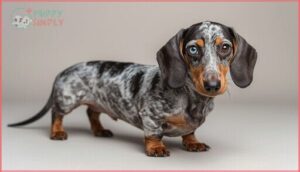This site is supported by our readers. We may earn a commission, at no cost to you, if you purchase through links.
A marbled coat that looks like someone splattered paint across a canvas—that’s your first clue you’re looking at a dapple dachshund. This striking pattern isn’t just for show, though it certainly turns heads at the dog park. The dappling comes from a specific gene called Merle, which creates those signature mottled patches in shades of silver, chocolate, or cream against darker base colors.
While these low-slung hunters trace their roots back to 15th century Germany, the dapple variation brings its own set of considerations beyond the breed’s already distinctive long body and short legs. Understanding what makes dapples unique—from their genetics to their care requirements—helps you decide if this eye-catching variation fits your home, and more importantly, how to keep one healthy and thriving for years to come.
Table Of Contents
- Key Takeaways
- Dapple Dachshund Breed Overview
- Dapple Dachshund Appearance
- Dapple Dachshund Temperament
- Dapple Dachshund Health Issues
- Caring for a Dapple Dachshund
- Dapple Dachshund Breeding and Adoption
- Frequently Asked Questions (FAQs)
- How do you differentiate between dapple and brindle dachshunds?
- Can dapple dachshunds live in apartments comfortably?
- How long do dapple dachshunds typically live?
- Are dapple dachshunds hypoallergenic or low-shedding?
- What vaccinations do dapple dachshund puppies need?
- Do dapple dachshunds bark excessively or frequently?
- Conclusion
Key Takeaways
- The dapple pattern comes from the Merle gene and creates unique mottled coats, but breeding two dapples together produces double dapple puppies with severe health risks including up to 36% facing blindness and 30% suffering deafness.
- Intervertebral Disc Disease (IVDD) affects roughly one in four dachshunds due to their elongated spine, with surgical intervention within 24 hours achieving up to 90% recovery rates for severe cases.
- These dogs need 45-60 minutes of daily exercise split into shorter sessions to protect their spine, while avoiding stairs and jumping, and they require careful weight management since obesity significantly increases IVDD risk.
- Their stubborn, intelligent temperament demands early training using positive reinforcement in sessions under 10 minutes, plus consistent socialization before 12 weeks to prevent fear-based aggression and excessive barking.
Dapple Dachshund Breed Overview
The dapple dachshund isn’t a separate breed, but rather a striking color variation of the beloved dachshund. These dogs carry a unique genetic trait that creates their distinctive mottled coat pattern, setting them apart from their solid-colored cousins.
Understanding where they came from, how they’re officially recognized, and why they’ve captured so many hearts will help you appreciate what makes these little dogs special.
Origin and History
The Dapple Dachshund breed information traces back to 15th century Germany, where early ancestry shaped these notable dogs for badger hunting. Breed development emphasized their low-slung bodies and short legs, perfect for tunnel work. Coat origins, including the distinctive dapple pattern, appeared by the 19th century.
Dapple Dachshunds are also known to be prone to certain health issues. Royal popularity surged when Queen Victoria embraced the breed, cementing the Dachshund breed’s place in homes worldwide.
Breed Recognition and Standards
You’ll find AKC recognition for dapple Dachshunds dates back to 1885, with the breed standard clearly outlining acceptable dapple genetics and color patterns. Both AKC and UKC standards permit the dapple coat, though double dapples face show disqualifications due to health concerns.
White markings beyond the chest, excessive piebald patterns, or structural faults can disqualify your dog from conformation events, so understanding breed characteristics matters if you’re considering showing.
Dachshunds are known for their strong prey drive and may chase after small animals.
Popularity and Cultural Influence
Social media has transformed how you encounter dapple Dachshunds today, with breed visibility skyrocketing since 2014 when registrations began a 120% climb. By 2023, they reached No. 6 among dog breeds, a dramatic leap from 13th place just years earlier.
Their cultural footprint includes:
- Instagram influencers with 140,000+ followers showcasing “weenie dog” culture
- Media portrayal in films and advertisements emphasizing their quirky charm
- Fashion symbol status inspiring breed-specific clothing trends worldwide
- Internet culture driving viral content and online community engagement
- Brand partnerships generating millions of impressions through dachshund marketing
This visibility brings responsibility, as prospective owners sometimes overlook Dachshund breed standards and health considerations when drawn by trends alone.
Dapple Dachshund Appearance
The dapple dachshund’s appearance is where genetics meets artistry, creating a coat pattern that’s as unpredictable as it’s beautiful. While the mottled patches are their signature feature, there’s more to their look than just color.
Let’s break down what makes these dogs stand out, from their distinctive coats to their classic wiener dog build.
Coat Patterns and Colors
The Merle gene creates that distinctive dapple pattern you’ll notice on these dogs, producing lighter and darker marbled patches across their coats. Each dapple dachshund carries a unique, one-of-a-kind pattern, whether it’s black and tan, chocolate, red, or blue variations.
Double dapples show extensive white markings and carry significant health risks, which is why ethical breeders avoid pairing two dapple parents.
| Dapple Color Variation | Visual Characteristics |
|---|---|
| Black and Tan Dapple | Black base with tan points and lighter speckles |
| Red Dapple | Red-brown base with scattered lighter patches |
| Blue and Tan Dapple | Gray base with tan markings and dapple mottling |
Size and Weight Variations
Your dachshund’s size category determines more than just appearance; it shapes health risks and care needs. Standard size dachshunds weigh 16 to 32 pounds, while miniature dachshunds stay under 11 pounds at maturity.
Tweenie range dogs fall between these official brackets, weighing 11 to 16 pounds. Rabbit dachshunds, the smallest variety, weigh less than 8 pounds and aren’t recognized by most kennel clubs.
Distinguishing Features
Beyond size categories, you’ll recognize a dapple dachshund by its marbled coat pattern, where lighter patches interrupt the base color. The merle gene creates this unique dapple pattern and also influences eye color, producing striking blue eyes or heterochromia.
- Coat type varies: smooth, wire-haired, or long-haired textures all showcase dapple dachshund color patterns
- Eye color signals genetic markers: blue or parti-colored eyes link directly to the dapple gene
- Nose variations occur: lighter pigmentation sometimes appears, especially in double dapples
- Body shape remains classic: elongated torso, short legs, and paddle-shaped paws define dachshund characteristics regardless of coat
Dapple Dachshund Temperament
Dapple dachshunds have personalities that are just as distinctive as their spotted coats, and understanding their temperament helps you decide if this breed fits your lifestyle. These dogs are clever and loyal, but they also come with a stubborn streak that can surprise first-time owners.
Let’s look at the key personality traits, how they interact with kids and other pets, and what makes them work as family companions.
Personality Traits
Think of them as “big dogs in small packages.” Your dapple dachshund’s personality reflects high intelligence levels, but paired with an independent streak that creates training challenges. These clever dogs form intense emotional bonds, usually choosing one favorite person. Around 22% show excessive barking, a trait you’ll want to manage early through consistent boundaries and positive reinforcement.
Understanding dapple dachshund temperament and training needs helps you nurture their loyalty while managing behavioral tendencies. Their dog temperament combines playfulness with tenacity, making these dapple dachshund characteristics both charming and demanding. Recognition of dapple dachshund breed characteristics, including their vocal nature and social behavior patterns, ensures you’re prepared for the commitment. Their dog behavior requires patient handling, channeling that vivacious energy appropriately while respecting their hunting heritage.
| Trait Category | Key Characteristics | Management Tips |
|---|---|---|
| Intelligence & Independence | Problem-solving skills, stubborn behavior, bold despite size | Start training early, use positive methods |
| Loyalty & Bonds | Deep attachment to owners, protectiveness, possible jealousy | Socialize during puppyhood, address separation anxiety |
| Vocal & Reactive | Frequent barking, strong prey drive, wariness of strangers | Set firm boundaries, provide mental stimulation |
Behavior With Children and Other Pets
How do your kids and existing pets fit into life with a dapple dachshund? Pet socialization during puppyhood dramatically shapes household dynamics and family integration. Dachshund puppies raised alongside children usually develop patience, though child safety requires teaching gentle handling to prevent defensive nipping. Their dog behavior around other pets depends heavily on early exposure and ongoing supervision, since their hunting instincts can trigger canine aggression toward smaller animals.
- Introduce your dapple dachshund to children gradually, supervising all interactions to prevent accidental injuries from rough play
- Watch for warning signals like stiffening or growling, teaching kids to recognize when your dog needs space
- Pair your dachshund with similar-sized companions, as rough play with larger dogs risks spinal injury
- Manage their natural prey drive around small pets through consistent boundaries and positive reinforcement training
- Monitor individual dog temperament closely, since dapple dachshund temperament and training needs vary considerably between dogs
Socialization and Suitability as Family Pets
Successful family integration starts with planned household adaptation from day one, especially for dapple dachshund adoption candidates evaluating pet integration potential. Early dapple dachshund puppy costs pale beside behavioral investments—exposing puppies to varied environments before 12 weeks reduces adult problems by 60%.
Family-oriented dog breeding prioritizes temperament, while systematic dachshund puppy socialization through child interaction and social learning builds lifelong adaptability. Your consistency determines their success.
Dapple Dachshund Health Issues
Dapple dachshunds face some unique health challenges, many of which stem from their distinctive build and genetics. While they’re generally hardy dogs, understanding the common issues that affect the breed can help you catch problems early and keep your pup comfortable for years to come.
Let’s look at the most important health concerns you should know about.
Intervertebral Disc Disease (IVDD)
IVDD stands as the most serious health problem dachshunds face, with roughly one in four developing spinal disc disease during their lifetime. This genetic health condition, linked to IVDD genetics involving the FGF4 gene, generally appears between ages four and eight.
Early diagnosis matters tremendously—surgical intervention within 24 hours can achieve up to 90% recovery rates for severe cases, though the economic burden often reaches $6,000 to $12,000. Post-op rehab over 12 weeks remains essential for full recovery.
Eye Conditions and Progressive Retinal Atrophy
Beyond spinal concerns, your dapple dachshund faces genetic health conditions affecting vision. Progressive Retinal Atrophy (PRA) gradually leads to blindness, often starting with night vision struggles between ages one and two. Other dachshund eye disorders include cataracts and iris abnormalities.
PRA genetic screening helps identify carriers before breeding, while dapple eye defects remain manageable through vision loss adaptation strategies and regular veterinary ophthalmology checks.
Double Dapple Health Risks
Breeding two dapples creates double dapple puppies with severe genetic health conditions. Up to 36% experience vision defects like microphthalmia or blindness, while congenital deafness affects roughly 30%. Structural defects, including limb malformations, occur in 12–18% of cases.
Breeding two dapples produces double dapple puppies with devastating risks: up to 36% face blindness, 30% suffer deafness, and many develop limb malformations
These eye conditions and health problems reduce lifespan by two to four years, which is why welfare warnings from kennel clubs explicitly ban this breeding practice.
Caring for a Dapple Dachshund
Caring for a dapple dachshund requires attention to their unique physical needs and spirited personality. These long-bodied dogs thrive when you balance their grooming, exercise, diet, and mental enrichment in ways that protect their spine and keep them engaged.
Let’s look at the key areas where your daily care makes the biggest difference in your dapple’s health and happiness.
Grooming and Coat Maintenance
When grooming your dapple dachshund, brushing techniques vary by coat type—long-haired varieties need daily attention with pin brushes to prevent matting, while smooth-coated dogs only require brushing once or twice weekly. To maintain coat color vibrancy and control shedding, consider these dog grooming essentials:
- Bathe every three months using fragrance-free shampoo
- Use leave-in conditioning sprays for softness
- Include omega-3-rich foods for dietary impact on coat quality
- Clean ears and trim nails during monthly grooming sessions
Proper dapple dachshund grooming and care prevents skin irritation and keeps shedding manageable throughout your home.
Exercise and Activity Needs
Your dapple dachshund needs 45–60 minutes of daily exercise, though miniature dachshunds do well with 30–35 minutes. Break walks into shorter sessions to protect that long spine, and mix in fetch or puzzle toys for mental stimulation.
Avoid stairs and jumping—these increase IVDD risk considerably. Swimming offers low-impact strength building, especially for older dogs, while harnesses prevent neck strain during walks.
Diet and Nutrition
You’ll want to feed your dapple dachshund 30–40 calories per pound daily, adjusting for activity level and age. A typical 20-pound adult needs roughly 550 kilocalories to maintain a healthy weight.
Choose AAFCO-approved food with quality protein, omega-3s, and joint-supporting nutrients like glucosamine.
Measure portions carefully, split meals twice daily, and keep treats under 10% of total caloric intake to prevent obesity—a major IVDD risk factor.
Training and Mental Stimulation
You’ll find dapple dachshund training requires patience, as these stubborn pups rank among the toughest breeds for obedience. Keep sessions under 10 minutes, repeated daily, using positive reinforcement to improve responsiveness by 40%.
Mental stimulation through puzzle toys and scent games prevents destructive behaviors while engaging their hunting instincts.
Early puppy socialization before 12 weeks reduces fear-based aggression markedly, supporting better cognitive development long-term.
Dapple Dachshund Breeding and Adoption
Understanding how the dapple pattern works and where to find a healthy puppy can save you from heartbreak down the road. Responsible breeding practices matter more with dapple dachshunds than most other breeds, since genetics directly affect your dog’s quality of life.
Let’s look at what you need to know about the dapple gene, ethical breeders, and what to expect when you’re ready to bring one home.
Genetics of The Dapple Pattern
The dapple pattern you see on your Dachshund starts with a genetic mutation in the PMEL gene, which controls pigment distribution. This merle gene behaves as a dominant trait, meaning one copy creates the classic mottled coat.
Dapple inheritance follows straightforward rules: breeding two dapples produces a 25% chance of double dapple offspring, who face serious congenital risks. Genetic testing through veterinary labs definitively identifies carriers, including cryptic PMEL variants invisible to the eye.
Ethical Breeding Practices
Choosing a breeder who prioritizes health over profit protects your future companion. Over 90% of reputable breeders conduct genetic testing to screen for hereditary risks, and they’ll never pair two dapples together. Look for breeder accreditation, transparent health guarantees, and early puppy socialization practices.
Responsible ownership starts before you bring your dog home, so ask about breeding dog health standards and expect documentation of every health test performed.
Puppy Costs and Adoption Considerations
Puppy adoption through reputable dog breeders generally costs $1,500 to $3,500, while rescue organizations charge under $400.
When weighing breeder vs. rescue, remember that initial expenses include veterinary care, supplies, and food—totaling $900 to $2,600 in year one. Ongoing costs run $600 to $3,600 annually, and health risks like IVDD may require $2,000 to $4,000 in surgeries.
Financial aid exists through Dachshund-specific nonprofits for qualified owners.
Frequently Asked Questions (FAQs)
How do you differentiate between dapple and brindle dachshunds?
Dapple creates irregular, mottled patches of diluted color, while brindle displays parallel dark stripes over lighter areas.
Eye color often differs too—dapples can have blue eyes, but brindle dogs usually don’t.
Can dapple dachshunds live in apartments comfortably?
Over 120% of dachshund registrations have surged since 2014, yet space compatibility remains excellent for apartments.
You’ll need 45–60 minutes of daily dog exercise, manage noise concerns through training, and address health factors like IVDD with ramps.
How long do dapple dachshunds typically live?
You can expect your dog to live 12 to 16 years on average.
Lifespan factors include genetics, care strategies, and health risks like IVDD, which greatly affect dapple dachshund longevity trends and overall canine health outcomes.
Are dapple dachshunds hypoallergenic or low-shedding?
Unfortunately, shedding patterns mean these spotted companions aren’t hypoallergenic dogs.
Longhaired dapple dachshunds shed moderately year-round, releasing dander continuously, while the dapple pattern itself doesn’t reduce allergen production or improve low shedding breeds status.
What vaccinations do dapple dachshund puppies need?
Your puppy needs core vaccines (distemper, parvovirus, adenovirus) starting at 6-8 weeks, with boosters every 2-4 weeks until 16 weeks.
Additionally, the rabies vaccine should be administered at 12-16 weeks, following proper vaccine timing for ideal puppy health.
Do dapple dachshunds bark excessively or frequently?
Like little alarm clocks on legs, dapple dachshunds often vocalize frequently due to their hunting heritage.
Barking triggers include strangers, boredom, and separation anxiety, making noise management and dog training essential for controlling excessive barking and vocalization patterns.
Conclusion
Like the badger hunters they descended from, dapple dachshunds require patience and understanding to thrive. Their distinctive coats carry genetic considerations you can’t ignore, especially regarding breeding practices and health screenings.
But when you match their care needs with consistent training, proper weight management, and attention to spinal health, these spirited companions offer years of loyalty.
The beauty of a dapple dachshund lies not just in their appearance, but in knowing exactly what they need from you.














